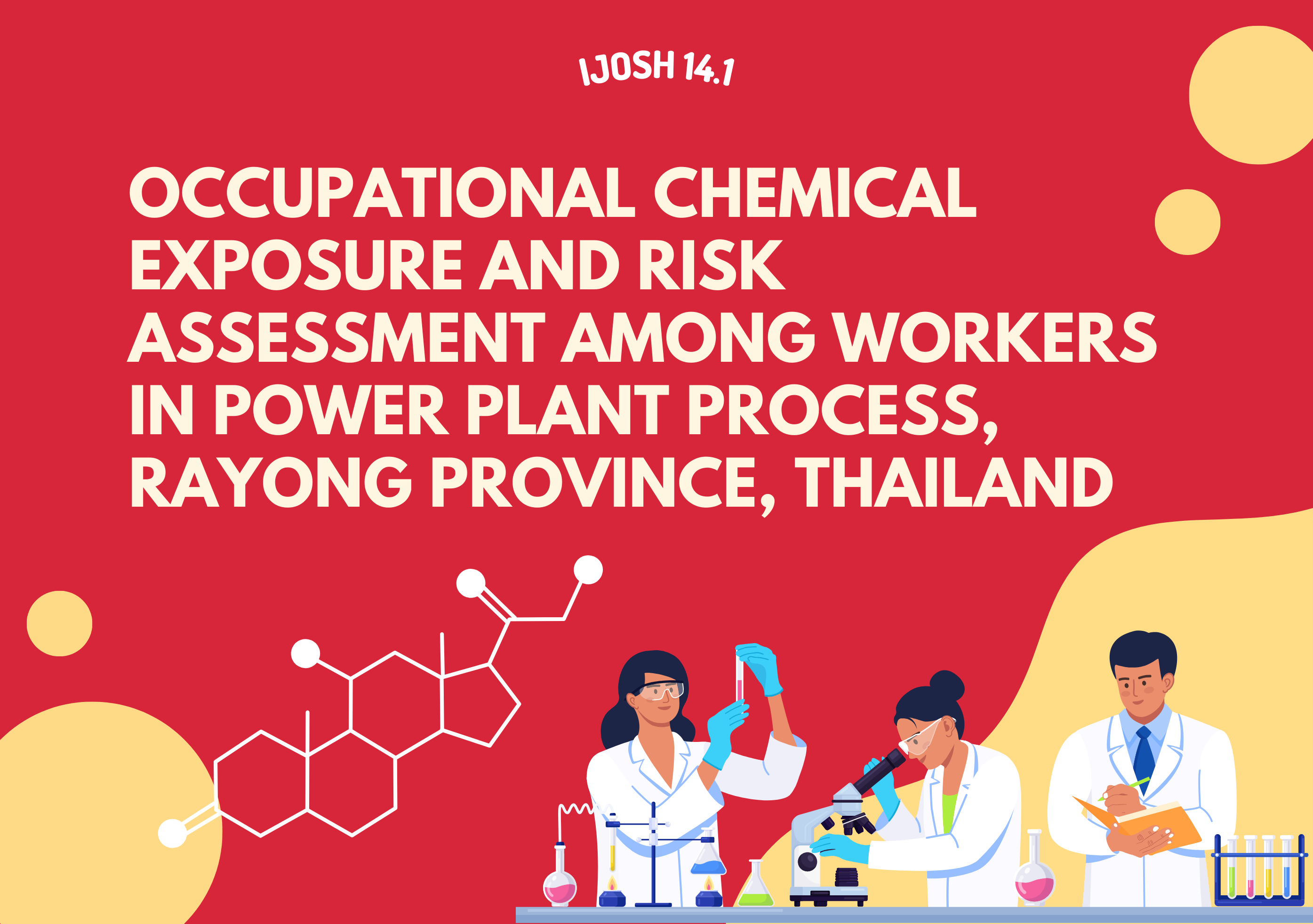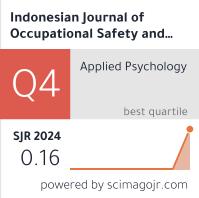Occupational Chemical Exposure and Risk Assessment among Workers in Power Plant Process, Rayong Province, Thailand

Downloads
Introduction: The combined cycle power plant involves the use of highly hazardous chemicals, primarily utilized in water quality improvement processes and cooling systems. Employees are susceptible to potential health risks associated with exposure through inhalation, skin, and eye contact. This study aims to assess the risk of chemical exposure among employees in the power plant process. Methods: The analysis uses secondary data collected from chemical measurements in the workplace environment during the power plant's three-years of operation. Results: The analysis identified hydrogen peroxide, sodium hydroxide, sulfuric acid, and hydrochloric acid as commonly utilized in power plant operations, with exposure occurring primarily through inhalation. While industrial hygiene assessments over the past three years reported atmospheric concentrations below standard limits, health risk assessments highlighted these chemicals as presenting unacceptable but manageable risks to employee health. Furthermore, the presence of mutagenic and highly carcinogenic compounds was observed. Especially, exposure surveillance has not yet been incorporated into the production process for risk evaluation. Conclusion: Therefore, the results of the risk assessment indicate that exposure should be monitored by conducting industrial hygiene measurements for highly hazardous chemicals and conducting employee health risk assessments, as required by law, for all types of hazardous chemicals.
ACGIH ®. (2024). Threshold Limit Values (TLVs ® ) and Biological Exposure Indices (BEIs ® ) ACGIH Based on the Documentation of the Threshold Limit Values for Chemical Substances and Physical Agents & Biological Exposure Indices.
Ansar, M. A., et al. (2021) Occupational Exposure to Hazards and Volatile Organic Compounds in Small-scale Plastic Recycling Plants in Thailand by Integrating Risk and Life Cycle Assessment Concepts, Journal of Cleaner Production, 329. https://doi.org/10.1016/j.jclepro.2021.129582
Ayuningtyas, A. I. and Nasri, S. M. (2021) Health Risk Assessment of Physical and Chemical Hazards in the Painting Area of a Manufacturing Company, Indonesian Journal of Occupational Safety and Health, 10(2). https://doi.org/10.20473/ijosh.v10i2.2021.247-257.
Chaiklieng, S., Suggaravetsiri, P. and Autrup, H. (2019) Risk Assessment on Benzene Exposure among Gasoline Station Workers, International Journal of Environmental Research and Public Health, 16(14). https://doi.org/10.3390/ijerph16142545.
Chaiklieng, S., et al. (2021). Exposure to Benzene and Toluene of Gasoline Station Workers in Khon Kaen, Thailand and Adverse Effects, Human and Ecological Risk Assessment, 27(7). https://doi.org/10.1080/10807039.2021.1910010.
Chaivanich, K. (2022). Health Risk Assessment from Using Benzene and Diesel among Employees at a Gas Station of Petroleum Limited Partnership, Academic Journal of Science and Applied Science, 2, 21–35. https://ajsas.uru.ac.th/files_complete/1668915308_5783.pdf.
Fatemi, F., Dehdashti, A., and Jannati, M.. (2022). Implementation of Chemical Health, Safety, and Environmental Risk Assessment in Laboratories: A Case-Series Study, Frontiers in Public Health, 10.
Horn, G. P., et al. (2022). Hierarchy of Contamination Control in the Fire Service: Review of Exposure Control Options to Reduce Cancer Risk, Journal of Occupational and Environmental Hygiene, 19(9),538-557. https://doi.org/10.1080/15459624.2022.2100406.
International Council of Chemical Associations. (2011). Global Product Strategy ICCA Guidance on Chemical Risk Assessment Product Stewardship in action: Sound Chemicals Management is a Global Responsibility..
International Labour Organization. (2021) Exposure to Hazardous Chemicals at Work and Resulting Health Impacts: A Global Review.
Jirapongsuwan, A., et al. (2019) Work-related Symptoms Due to Chemical use among Hairdressers in Bangkok, Thailand, Southeast Asian Journal of Tropical Medicine and Public Health, 50(1).
Kuntawee, C., et al. (2020) Exposure to Heavy Metals in Electronic Waste Recycling in Thailand, International Journal of Environmental Research and Public Health, 17(9). https://doi.org/10.3390/ijerph17092996
Laor, P., et al. (2019) Health Risk and Health Status of Farmers Exposed to Chemical Pesticides used in Agriculture, Journal of Current Science and Technology, 9(2).
Motahari, A., et al. (2023) Health Risk Assessment of Occupational Exposure to Chemical Materials in a Combined-Cycle Power Plant, Journal of Advances in Environmental Health Research, 11(4). https://doi.org/10.34172/jaehr.1289.
National Institute for Occupational Safety and Health (NIOSH). (2013). Recommended Exposure Limits (RELs) (National Institute for Occupational Safety and Health.
National Institutes of Health (NIH). (2024). PubChem: Explore Chemistry. National Institutes of Health.. https://pubchem.ncbi.nlm.nih.gov/.
Notification of Ministry of Industry: Thailand Industrial Standard for Chemical Health Risk Assessment for Industrial Worker B.E. 2555. (A.D. 2012). The Royal of Thai Government Gazette of The Kingdom of Thailand 1 (2012).
Notification of the Department of Labor Protection and Welfare, Subject: The Concentration Limit of Hazardous Chemical, B.E.2560 (A.D.2017) The Royal of Thai Government Gazette of The Kingdom of Thailand 1 (2017).
Occupational Health and Safety and Environment Act B.E. 2554 (A.D. 2011). The Royal Thai Government Gazette of The Kingdom of Thailand 5 (2011).
Occupational Safety and Health Administration (OSHA). (1970). Permissible Exposure Limits (PELs) – Annotated Tables. https://www.osha.gov/annotated-pels.
Rai, R.,et al. (2020) Occupational Exposures to Hazardous Chemicals and Agents among Healthcare Workers in Bhutan, American Journal of Industrial Medicine, 63(12). https://doi.org/10.1002/ajim.23192.
Rovira, J. and Domingo, J. L. (2019) Human Health Risks due to Exposure to Inorganic and Organic Chemicals from Textiles: A Review. Environmental Research, 168. https://doi.org/10.1016/j.envres.2018.09.027
Tangyosthakijjakul, S. and Chernbamrung, T. (2018) The Appropriation of Chemical and Physical Health Risk Examination of Establishment in Rayong Province and Details of the Result Reporting to Labor Inspector. Journal of Safety and Health, 11(3), 35–46.
Thailand institute of Occupational Safety and Health (Public Organization) (2021). Manual for Occupational Health Risk Assessment of Hazardous Chemicals (Thailand institute of Occupational Safety and Health Vol. 1). Thailand Institute of Occupational Safety and Health.
Thatsanat, W., and Chaiklieng, S. (2019) Health Risk Assessment of Chemical Exposure among Pulp and Paper Mill Workers in Northeastern Thailand. The Public Health Journal of Burapha University, 14(2), 103–117.

This work is licensed under a Creative Commons Attribution-NonCommercial-ShareAlike 4.0 International License.

In order to be accepted and published by The Indonesian Journal of Occupational Safety and Health, Author(s) who submit an article should complete all the review process. The copyright of received articles assigned to the The Indonesian Journal of Occupational Safety and Health and Department of Safety and Health, Universitas Airlangga as publishers of the journal. The intended copyright includes the rights to publish articles in various forms (including reprints).
The Editorial Team of The Indonesian Journal Of Occupational Safety and Health and Department of Safety and Health strive to ensure that no errors occur in the articles that have been published, both data errors and statements in the article.
Users of this website will be licensed to use materials from this website following the Creative Commons Attribution-NonCommercial-ShareAlike 4.0 International License. No fees charged. Please use the materials accordingly.
------------------------------------------------------------------------------------------------------------------------------------------------------------------------------------------
Attribution ” You must give appropriate credit, provide a link to the license, and indicate if changes were made. You may do so in any reasonable manner, but not in any way that suggests the licensor endorses you or your use.
NonCommercial ” You may not use the material for commercial purposes.
ShareAlike ” If you remix, transform, or build upon the material, you must distribute your contributions under the same license as the original.







 How to Submit Articles in OJS
How to Submit Articles in OJS

























